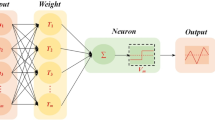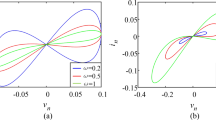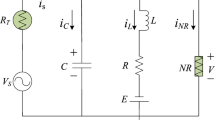Abstract
In this paper, the dynamics of a non-autonomous tabu learning two-neuron model is investigated. The model is obtained by building a tabu learning two-neuron (TLTN) model with a composite hyperbolic tangent function consisting of three hyperbolic tangent functions with different offsets. The possibility to adjust the compound activation function is exploited to report the sensitivity of non-trivial equilibrium points with respect to the parameters. Analysis tools like bifurcation diagram, Lyapunov exponents, phase portraits, and basin of attraction are used to explore various windows in which the neuron model under the consideration displays the uncovered phenomenon of the coexistence of up to six disconnected stable states for the same set of system parameters in a TLTN. In addition to the multistability, nonlinear phenomena such as period-doubling bifurcation, hysteretic dynamics, and parallel bifurcation branches are found when the control parameter is tuned. The analog circuit is built in PSPICE environment, and simulations are performed to validate the obtained results as well as the correctness of the numerical methods. Finally, an encryption/decryption algorithm is designed based on a modified Julia set and confusion–diffusion operations with the sequences of the proposed TLTN model. The security performances of the built cryptosystem are analyzed in terms of computational time (CT = 1.82), encryption throughput (ET = 151.82 MBps), number of cycles (NC = 15.80), NPCR = 99.6256, UACI = 33.6512, χ2-values = 243.7786, global entropy = 7.9992, and local entropy = 7.9083. Note that the presented values are the optimal results. These results demonstrate that the algorithm is highly secured compared to some fastest neuron chaos-based cryptosystems and is suitable for a sensitive field like IoMT security.

























Similar content being viewed by others
Explore related subjects
Discover the latest articles and news from researchers in related subjects, suggested using machine learning.References
Beyer D, Ogier RG (1991) Tabu learning: a neural network search method for solving nonconvex optimization problems. In: [Proceedings] 1991 IEEE International Joint Conference on Neural Networks, pp 953–961. IEEE
Glover F (1990) Tabu search—part II. ORSA J Comput 2(1):4–32
Glover F (1989) Tabu search—part I. ORSA J Comput 1(3):190–206
Li C, Chen G, Liao X (2005) Yu, J, Chaos: Hopf bifurcation and chaos in tabu learning neuron models. Int. J. Bifurcation Chaos 15(08):2633–2642
Zhou X, Wu Y, Li Y, Ye Y (2006) Hopf bifurcation analysis on a tabu learning single neuron model in the frequency domain. In: 2006 International Conference on Communications, Circuits and Systems 2006, pp 2042–2045. IEEE
Xiao M, Cao J (2008) Bifurcation analysis on a discrete-time tabu learning model. J Comput Appl Math 220(1–2):725–738
Jun C, Chun-Guang L (2011) Circuit design of tabu learning neuron models and their dynamic behavior. Acta Phys Sin 60(2):020502
Li Y (2011) Hopf bifurcation analysis in a tabu learning neuron model with two delays. ISRN Appl Math. https://doi.org/10.5402/2011/636732
Bao B, Hou L, Zhu Y, Wu H, Chen M (2020) Bifurcation analysis and circuit implementation for a tabu learning neuron model. AEU Int J Electron Commun 121:153235
Zhu D, Hou L, Chen M, Bao B (2020) FPGA-based experiments for demonstrating bi-stability in tabu learning neuron model. Circuit World. https://doi.org/10.1108/CW-12-2019-0189
Bao B, Chen C, Bao H, Zhang X, Xu Q, Chen M (2019) Dynamical effects of neuron activation gradient on Hopfield neural network: numerical analyses and hardware experiments. Int J Bifur Chaos 29(04):1930010
Bao B, Qian H, Wang J, Xu Q, Chen M, Wu H, Yu Y (2017) Numerical analyses and experimental validations of coexisting multiple attractors in Hopfield neural network. Nonlinear Dyn 90(4):2359–2369
Bao B, Qian H, Xu Q, Chen M, Wang J, Yu Y (2017) Coexisting behaviors of asymmetric attractors in hyperbolic-type memristor based Hopfield neural network. Front Comput Neurosci 11:81
Chen C, Bao H, Chen M, Xu Q, Bao B (2019) Non-ideal memristor synapse-coupled bi-neuron Hopfield neural network: Numerical simulations and breadboard experiments. AEU-Int J Electron Commun 111:152894
Chen C, Chen J, Bao H, Chen M, Bao B (2019) Coexisting multi-stable patterns in memristor synapse-coupled Hopfield neural network with two neurons. Nonlinear Dyn 95(4):3385–3399
Dan Z, Huang W, Huang YJ (2010) Chaos and rigorous verification of horseshoes in a class of Hopfield neural networks. Neural Comput Appl 19(1):159–166
Duan S, Dong Z, Hu X, Wang L, Li H (2016) Applications: Small-world Hopfield neural networks with weight salience priority and memristor synapses for digit recognition. Neural Comput Appl 27(4):837–844
Hopfield JJ (1995) Pattern recognition computation using action potential timing for stimulus representation. Nature 376(6535):33–36
Hopfield JJ (1984) Neurons with graded response have collective computational properties like those of two-state neurons. Proc Natl Acad Sci 81(10):3088–3092
Lakshmi C, Thenmozhi K, Rayappan JBB, Amirtharajan R (2019) Applications: Hopfield attractor-trusted neural network: an attack-resistant image encryption. Neural Comput Appl 13:1–13
Mathias AC, Rech PC (2012) Hopfield neural network: the hyperbolic tangent and the piecewise-linear activation functions. Neural Netw 34:42–45
Njitacke Z, Kengne J, Fostin H (2019) A plethora of behaviors in a memristor based Hopfield neural networks (HNNs). Int J Dyn Control 7(1):36–52
Njitacke Z, Kengne J, Fozin TF, Leutcha B, Fotsin HB (2019) Dynamical analysis of a novel 4-neurons based Hopfield neural network: emergences of antimonotonicity and coexistence of multiple stable states. Int J Dyn Control 7(3):823–841
Njitacke ZT, Kengne J (2018) Complex dynamics of a 4D Hopfield neural networks (HNNs) with a nonlinear synaptic weight: Coexistence of multiple attractors and remerging Feigenbaum trees. AEU-Int J Electron Commun 93:242–52
Njitacke ZT, Kengne J (2019) Nonlinear dynamics of three-neurons-based Hopfield neural networks (HNNs): Remerging Feigenbaum trees, coexisting bifurcations and multiple attractors. J Circuits Syst Comput 28(07):1950121
Njitacke ZT, Isaac SD, Kengne J, Negou AN, Leutcho GD (2020) Extremely rich dynamics from hyperchaotic Hopfield neural network: hysteretic dynamics, parallel bifurcation branches, coexistence of multiple stable states and its analog circuit implementation. Eur Phys J Special Topics 229:1133–1154
Njitacke ZT, Kengne J, Fotsin HB (2020) Coexistence of multiple stable states and bursting oscillations in a 4d Hopfield neural network. Circuits Syst Signal Process 39(7):3424–3444
Xu Q, Song Z, Bao H, Chen M, Bao B (2018) Two-neuron-based non-autonomous memristive Hopfield neural network: numerical analyses and hardware experiments. AEU-Int J Electron Commun 96:66–74
Xu Q, Song Z, Qian H, Chen M, Wu P, Bao B (2018) Numerical analyses and breadboard experiments of twin attractors in two-neuron-based non-autonomous Hopfield neural network. Eur Phys J Spec Top 227(7–9):777–786
Yang J, Wang L, Wang Y, Guo T (2017) A novel memristive Hopfield neural network with application in associative memory. Neurocomputing 227:142–14
Zheng YG, Bao LJ (2014) Slow–fast dynamics of tri-neuron Hopfield neural network with two timescales. Commun Nonlinear Sci Numer Simul 19(5):1591–1599
Bao B, Zhu Y, Li C, Bao H, Xu Q (2020) Global multistability and analog circuit implementation of an adapting synapse-based neuron model. Nonlinear Dyn 101:1–14
Njitacke ZT, Isaac SD, Nestor T, Kengne J (2020) Window of multistability and its control in a simple 3D Hopfield neural network: application to biomedical image encryption. Neural Comput Appl. https://doi.org/10.1007/s00521-020-05451-z
Gao T, Chen Z (2008) A new image encryption algorithm based on hyper-chaos. Phys Lett A 372(4):394–400
Lakshmi C, Thenmozhi K, Rayappan JBB, Amirtharajan R (2020) Hopfield attractor-trusted neural network: an attack-resistant image encryption. Neural Comput Appl 32(15):11477–11489
Wang X-Y, Li Z-M (2019) A color image encryption algorithm based on Hopfield chaotic neural network. Opt Lasers Eng 115:107–118
Zhou Y, Cao W, Chen CP (2014) Image encryption using binary bitplane. Signal Process 100:197–207
Doubla Isaac S, Njitacke ZT, Kengne J (2020) Effects of low and high neuron activation gradients on the dynamics of a simple 3D hopfield neural network. Int J Bifur Chaos 30(11):2050159
Kamdjeu Kengne L, Njitacke ZT, Pone JM, Tagne HK (2020) The effects of a constant excitation force on the dynamics of an infinite-equilibrium chaotic system without linear terms: analysis, control and circuit simulation. Int J Bifur Chaos 30(15):2050234
Bao B, Hou L, Zhu Y, Wu H, Chen M (2020) Bifurcation analysis and circuit implementation for a tabu learning neuron model. AEU-Int J Electron Commun 121:153235
Wolf A, Swift JB, Swinney HL, Vastano JA (1985) Determining Lyapunov exponents from a time series. Phys D: Nonlinear Phenom 16(3):285–317
Strogatz SH (1994) Nonlinear dynamics and chaos. Addison-Wesley, New York
Alligood KT, Sauer TD, Yorke JA (1996) Chaos. Springer, New York
Kengne J, Njitacke Z, Fotsin H (2016) Dynamical analysis of a simple autonomous jerk system with multiple attractors. Nonlinear Dyn 83(1):751–765
Babloyantz A, Lourenço C (1996) Brain chaos and computation. Int J Neural Syst 7(04):461–471
Fortuna L, Frasca M, Rizzo A (2003) Measurement: Chaotic pulse position modulation to improve the efficiency of sonar sensors. IEEE Trans Instrum Meas 52(6):1809–1814
Filali RL, Benrejeb M, Borne P, Simulation N (2014) On observer-based secure communication design using discrete-time hyperchaotic systems. Commun Nonlinear Sci Numer Simul 19(5):1424–1432
Duan S, Liao X (2007) An electronic implementation for Liao’s chaotic delayed neuron model with non-monotonous activation function. Phys Lett A 369(1–2):37–43
Rani M, Kumar V (2004) Superior mandelbrot set. J Korea Soc Math Educ Ser D Res Math Educ 8(4):279–291
Ashton K (2009) That ‘internet of things’ thing. RFID J 22(7):97–114
Islam SR, Kwak D, Kabir MH, Hossain M, Kwak K-S (2015) The internet of things for health care: a comprehensive survey. IEEE Access 3:678–708
Tsafack N, Kengne J, Abd-El-Atty B, Iliyasu AM, Hirota K, Abd EL-Latif AA (2020) Design and implementation of a simple dynamical 4-D chaotic circuit with applications in image encryption. Inf Sci 515:191–217
Yang X, He X, Zhao J, Zhang Y, Zhang S, Xie P (2020) COVID-CT-dataset: a CT scan dataset about COVID-19. arXiv prints, arXiv: 2003.13865
Hua Z, Zhou Y, Huang H (2019) Cosine-transform-based chaotic system for image encryption. Inf Sci 480:403–419
Kanso A, Ghebleh M (2017) An algorithm for encryption of secret images into meaningful images. Opt Lasers Eng 90:196–208
Nestor T, De Dieu NJ, Jacques K, Yves EJ, Iliyasu AM, El-Latif A, Ahmed A (2020) A multidimensional hyperjerk oscillator: dynamics analysis, analogue and embedded systems implementation, and its application as a cryptosystem. Sensors 20(1):83
Sneha P, Sankar S, Kumar AS (2020) A chaotic colour image encryption scheme combining Walsh-Hadamard transform and Arnold-Tent maps. J Ambient Intell Humaniz Comput 11(3):1289–1308
Tsafack N, Sankar S, Abd-El-Atty B, Kengne J, Jithin K, Belazi A, Mehmood I, Bashir AK, Song O-Y, Abd El-Latif AA (2020) A new chaotic map with dynamic analysis and encryption application in Internet of Health Things. IEEE Access 8:137731–137744
Wang X, Feng L, Zhao H (2019) Fast image encryption algorithm based on parallel computing system. Inf Sci 486:340–358
Alawida M, Samsudin A, Teh JS, Alkhawaldeh RS (2019) A new hybrid digital chaotic system with applications in image encryption. Signal Process 160:45–58
Gong L, Qiu K, Deng C, Zhou N (2019) An image compression and encryption algorithm based on chaotic system and compressive sensing. Opt Laser Technol 115:257–267
Luo Y, Yu J, Lai W, Liu L (2019) A novel chaotic image encryption algorithm based on improved baker map and logistic map. Multimedia Tools Appl 78(15):22023–22043
Diaconu A-V (2016) Circular inter–intra pixels bit-level permutation and chaos-based image encryption. Inf Sci 355:314–327
Jithin K, Sankar S (2020) Colour image encryption algorithm combining, Arnold map, DNA sequence operation, and a Mandelbrot set. J Inf Security Appl 50:102428
Liu L, Zhang Q, Wei X (2012) A RGB image encryption algorithm based on DNA encoding and chaos map. Comput Electr Eng 38(5):1240–1248
Volos CK, Kyprianidis IM, Stouboulos IN (2013) Image encryption process based on chaotic synchronization phenomena. Signal Processing 93(5):1328–1340
Modeste Nguimdo R, Tchitnga R, Woafo P (2013) Dynamics of coupled simplest chaotic two-component electronic circuits and its potential application to random bit generation. Chaos 23(4):043122
Acknowledgements
The authors are also grateful to the anonymous reviewers and the Associate Editor for their valuable comments, which helped improve the content of the present paper.
Funding
No funding has been used.
Author information
Authors and Affiliations
Corresponding author
Ethics declarations
Conflict of interest
The authors declare that they have no conflict of interest.
Data availability
The data used in this research work are available from the authors by reasonably request.
Additional information
Publisher's Note
Springer Nature remains neutral with regard to jurisdictional claims in published maps and institutional affiliations.
Rights and permissions
About this article
Cite this article
Doubla, I.S., Njitacke, Z.T., Ekonde, S. et al. Multistability and circuit implementation of tabu learning two-neuron model: application to secure biomedical images in IoMT. Neural Comput & Applic 33, 14945–14973 (2021). https://doi.org/10.1007/s00521-021-06130-3
Received:
Accepted:
Published:
Issue Date:
DOI: https://doi.org/10.1007/s00521-021-06130-3




